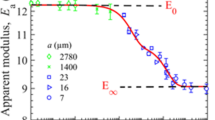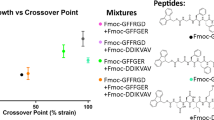Abstract
Protein-based hydrogels are commonly used as in vitro models of native tissues because they can mimic specific aspects of the three-dimensional extracellular matrix present in vivo. Bulk mechanical stimulation is often applied to these gels to determine the response of embedded cells to biomechanical factors such as stress and strain. This study develops and applies a linear, biphasic formulation of hydrogel mechanics that includes a Brinkman term to account for viscous effects. The model is used to predict fluid pressure, relative velocity, and estimated shear stress exerted on cells seeded within a cyclically strained collagen hydrogel with and without imposed cross flow. The model was validated using a confined compression creep test of a cardiac fibroblast-seeded collagen type I hydrogel, and the effect of the added Brinkman term was assessed. The model indicated that the effects of strain and interstitial fluid flow are strongly interdependent in the collagen hydrogel. Our results suggest that the contribution of the Brinkman term is greater in protein hydrogels than in native tissues, and that studies that apply cyclic strain to cell-seeded hydrogels should account for the induced interstitial fluid flow. This study, therefore, has relevance to the increasing number of studies that examine cellular responses to mechanical stresses using in vitro hydrogel models.










Similar content being viewed by others
References
Allen, T. D., and S. T. Schor. The contraction of collagen matrices by dermal fibroblasts. J. Ultrastruct. Res. 83:205–219, 1983.
Ateshian, G. A., H. Wang, and W. M. Lai. The role of interstitial fluid pressurization and surface porosities on the boundary friction of articular cartilage. J. Tribol. ASME 120:241–251, 1998.
Bell, E., B. Evarsson, and C. Merrill. Production of a tissue-like structure by contraction of collagen lattices by human fibroblasts of different proliferative potential in vitro. Proc. Natl. Acad. Sci. 76:1274–1278, 1979.
Bowen, R. Theory of mixtures. In: Continuum Physics, Vol. 3, edited by A. E. Eringen. New York, NY: Academic Press, 1976, pp. 1–127.
Breuls, R. G. M., B. G. Sengers, C. W. J. Oomens, C. V. C. Bouten, and F. P. T. Baaijens. Predicting local cell deformations in engineered tissue constructs: a multilevel finite element approach. J. Biomech. Eng. 124(2):198–208, 2002.
Chan, B., P. S. Donzelli, and R. L. Spilker. A mixed-penalty biphasic finite element formulation incorporating viscous fluids and material interfaces. Ann. Biomed. Eng. 28:589–597, 2000.
Chen, X., and M. Sarntinoranont. Biphasic finite element model of solute transport for direct infusion into nervous tissue. Ann. Biomed Eng. 35(12):2145–2158, 2007.
Chevallay, B., and D. Herbage. Collagen-based biomaterials as 3D scaffold for cell cultures: applications for tissue engineering and gene therapy. Med. Biol. Eng. Comput. 38:211–218, 2000.
Cummings, C. L., D. Gawlitta, R. M. Nerem, and J. P. Stegemann. Properties of engineered vascular constructs made from collagen, fibrin, and collagen–fibrin mixtures. Biomaterials 25(17):3699–3706, 2004.
Freed, L. E. Advanced tools for tissue engineering: scaffolds, bioreactors, and signaling. Tissue Eng. 12(12):3285–3305, 2006.
Galie, P. A., and J. P. Stegemann. Simultaneous application of interstitial flow and cyclic mechanical strain to a 3D cell-seeded hydrogel. Tissue Eng. C 17(5):527–536, 2011.
Galie, P. A., M. V. Westfall, and J. P. Stegemann. Reduced serum content and increased matrix stiffness promote the cardiac myofibroblast transition in 3D collagen matrices. Cardiovasc. Pathol. 2011 [Epub ahead of print].
Ghosh, K., et al. Cell adaptation to a physiologically relevant ECM mimic with different viscoelastic properties. Biomaterials 28(4):671–679, 2007.
Grinnell, F. Fibroblast biology in three-dimensional collagen matrices. Trends Cell Biol. 13(5):264–269, 2003.
Gudi, S. R. P., A. A. Lee, C. B. Clark, and J. A. Frangos. Equibiaxial strain and strain rate stimulate early activation of G proteins in cardiac fibroblasts. Am. J. Physiol. Cell Physiol. 274(5):C1424–C1428, 1998.
Guilak, F., and V. C. Mow. The mechanical environment of the chondrocyte: a biphasic finite element model of cell–matrix interactions in articular cartilage. J. Biomech. 33(12):1663–1673, 2000.
Holmes, M. H. Finite deformation theory of soft tissue: analysis of a mixture model in uniaxial compression. J. Biomech. Eng. 108:372–381, 1986.
Hou, J. S., M. H. Holmes, W. M. Lai, and V. C. Mow. Boundary conditions at the cartilage-synovial fluid interface for joint lubrication and theoretical verifications. J. Biomech. Eng. 111:78–87, 1989.
Kenyon, D. E. The theory of an incompressible solid–fluid mixture. Arch. Ration. Mech. Anal. 62:131–147, 1976.
Kisiday, J., M. Jin, B. Kurz, et al. Self-assembling peptide hydrogel fosters chondrocyte extracellular matrix production and cell division: implications for cartilage tissue repair. PNAS 99(15):9996–10001, 2002.
Mak, A. K., W. M. Lai, and V. C. Mow. Biphasic indentation of articular cartilage—I. Theoretical analysis. J. Biomech. 20(7):703–714, 1987.
McGuire, S., D. Zaharoff, and F. Yuan. Nonlinear dependence of hydraulic conductivity on tissue deformation during intratumoral infusion. Ann. Biomed Eng. 34(7):1173–1181, 2006.
Mow, V. C., S. C. Kuei, W. M. Lai, and C. G. Armstrong. Biphasic creep and stress relaxation of articular cartilage in compression: theory and experiments. J. Biomech. Eng. 102:73–84, 1980.
O’Brien, F. J., B. A. Harley, M. A. Waller, I. V. Yannas, L. J. Gibson, and P. J. Prendergast. The effect of pore size on permeability and cell attachment in collagen scaffolds for tissue engineering. Technol. Health Care 15:3–17, 2007.
Ramanujan, S., A. Pluen, T. D. McKee, E. B. Brown, Y. Boucher, and R. K. Jain. Diffusion and convection in collagen gels: implications for transport in the tumor interstitium. Biophys. J. 83:1650–1660, 2002.
Slomka, N., S. Or-Tzadikario, D. Sassun, and A. Gefen. Membrane-stretch-induced cell death in deep tissue injury: computer model studies. Cell. Mol. Bioeng. 2(1):118–132, 2009.
Spilker, R. L., J.-K. Suh, and V. C. Mow. A finite element formulation of the nonlinear biphasic model for articular cartilage and hydrated soft tissues including strain-dependent permeability. In: Computational Methods in Bioengineering, edited by R. L. Spilker, and B. R. Simon. New York: ASME, 1982, pp. 81–92.
Stegemann, J. P., H. Hong, and R. M. Nerem. Mechanical, biochemical, and extracellular matrix effects on vascular smooth muscle cell phenotype. J. Appl. Physiol. 98:2321–2327, 2005.
Stegemann, J. P., and R. M. Nerem. Phenotype modulation in vascular tissue engineering using biochemical and mechanical stimulation. Ann. Biomed. Eng. 31(4):391–402, 2003.
Stops, A. J. F., and L. A. McMahon. A finite element prediction of strain on cells in a highly porous collagen-glycosaminoglycan scaffold. J. Biomech. Eng. 130(6):100–111, 2008.
Stylianopoulos, T. Volume-averaging theory for the study of the mechanics of collagen networks. Comput. Methods Appl. Mech. Eng. 196(31–32):2981–2990, 2007.
Wang, D. M., and J. M. Tarbell. Modeling interstitial flow in an artery wall allows estimation of wall shear stress on smooth muscle Cells. J. Biomech. Eng. 117(3):358–364, 1995.
Weinand, C., I. Pomerantseva, C. M. Neville, R. Gupta, E. Weinberg, I. Madisch, F. Shapiro, H. Abukawa, M. J. Troulis, and J. P. Vacanti. Hydrogel-β-TCP scaffolds and stem cells for tissue engineering bone. Bone 38(4):555–563, 2006.
Acknowledgments
This study was supported in part by the Microfluidics in Biomedical Sciences Training Program at the University of Michigan, sponsored by the National Institute of Biomedical Imaging and Bioengineering.
Author information
Authors and Affiliations
Corresponding author
Additional information
Associate Editor Konstantinos Konstantopoulos oversaw the review of this article.
Rights and permissions
About this article
Cite this article
Galie, P.A., Spilker, R.L. & Stegemann, J.P. A Linear, Biphasic Model Incorporating a Brinkman Term to Describe the Mechanics of Cell-Seeded Collagen Hydrogels. Ann Biomed Eng 39, 2767–2779 (2011). https://doi.org/10.1007/s10439-011-0371-9
Received:
Accepted:
Published:
Issue Date:
DOI: https://doi.org/10.1007/s10439-011-0371-9




